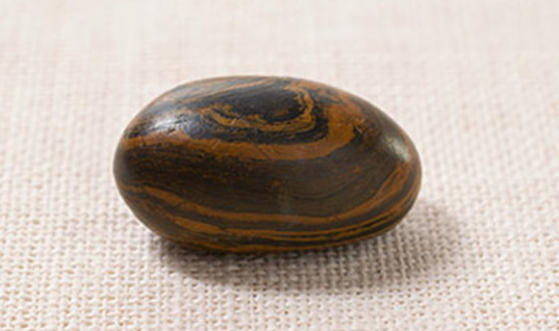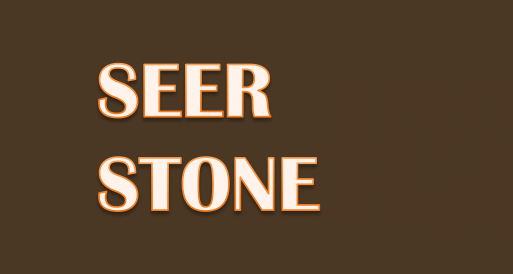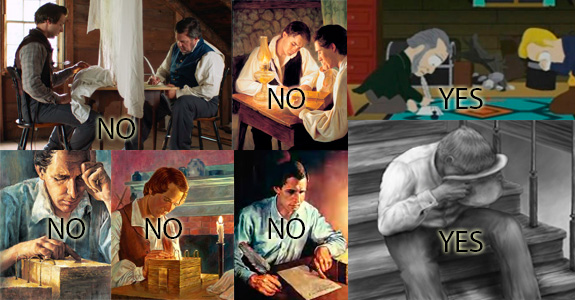8 Biblical Parallels to Joseph Smith’s Seer Stone

About a year ago, the Church of Jesus Christ of Latter-day Saints released a picture of Joseph Smith’s seer stone, the same stone that Smith used in the translation process of the Book of Mormon: Another Testament of Jesus Christ. South Park’s infamous episode on the satirical portrayal of the prophet and founder of the Church of Jesus Christ of Latter-day Saints, Joseph Smith, certainly sent shock waves into the hearts and minds of unsuspecting Mormon viewers and viewers with any attachment to the Church several years before this image was released by the Church.
A perception formed in the absence of an official church position, defense, or explanation (until recently), that the church attempted to hide this part of Mormon history. Curious Mormons and ex-Mormons wondered why South Park was the first place they’d ever have heard of this story. This is a legitimate concern for many, especially in this fast-paced world where traditional and social media and the blogosphere are dedicated to the “dark corners” of Mormonism.
Yet, the information has always been there and was even included in a July 1993 Ensign article (the Ensign in the Church’s official monthly publication). The point being, that it wasn’t until critics made a big deal out of it that the church SEEMED to be silent on the issue. There are good reasons why this story, just as many Bible stories (see below) do not often receive a whole lot of attention. Nevertheless, the seer stone was also mentioned in the 2002 Sunday school manual for that year’s study on the Doctrine and Covenants. In the Church’s fourth major companion book of scripture, the Doctrine and Covenants, it states in section 58:26,
For behold, it is not meet that I should command in all things; for he that is compelled in all things, the same is a slothful and not a wise servant; wherefore he receiveth no reward.
Mormons are taught throughout their church experience to study and familiarize themselves with the scriptures over the course of their lives, including official church publications and history. The surge of criticism and crises of faith inspired Church historians to produce new information on controversial church history and topics. In a recent talk to CES employees, M. Russell Ballard of the Quorum of the Twelve Apostles recently announced that seminary and institute teachers need to “inoculate” the members with church history via the Church Essays in hopes to reinforce members’ knowledge in order that they may be prepared to answer tough questions.
The idea of a prophet of God utilizing something like a seer stone is not accepted easily by many without invoking thoughts of deceit and suspicion on the character of Joseph Smith. However, as with any Biblical prophets whom God called them to His work, they often brought with them their own cultural baggage, human imperfections, and understandings. God was willing to use an obscure boy with no credentials to do a great work. Prophets are also not excused from the task that the rest of us face, that of relying on the atonement, repenting, and progressing to becoming more like God, just as any believer would.
Paul Hazard, an early twentieth-century historian on the European Enlightenment brought to light several critiques on the topics of miracles, magic, and religion during the early eighteenth century. Hazard highlighted the use of magic, divining rods, fortune telling, and all manner of superstitious practices across seventeenth and eighteenth century Europe.[1] Not long after, and across the ocean, this culture of magic persisted in the early decades of nineteenth-century American history, a culture in which Joseph Smith was neck deep in.[2]
Furthermore, from Richard Bushman’s Rough Stone Rolling: A cultural biography of Mormonism’s founder, the Smith family was on the verge of losing their farm and “doomed to revert to tenancy.”[3] The combined factors of a culture of magic and the Smith family’s socioeconomic status allow us a glimpse into the only life the young prophet knew. As a young twenty-something, this is hardly the ideal environment for someone of his standing to conjure up a 500-page book of scripture spanning a thousand years and containing great many truths pertaining to Christianity and the details that the future Restored Church (The Church of Jesus Christ of Latter-day Saints) would embody. Consider for a moment, the manner in which the Book of Mormon came into being in the words of Roger Nicholson:
“The 1830 edition of the Book of Mormon contains over 580 pages, which were dictated without repetition at a rate of seven to eleven-and-a-half pages per day. This is a significant accomplishment, regardless of the precise method used during the translation. A reasonable conclusion is that by allowing Joseph to dictate the entire Book of Mormon text in full view of witnesses without the process being obscured in any way, it significantly strengthens the position that Joseph was indeed receiving revelation rather than consulting other materials.”[4]
Former Latter-day Saints also accuse the Church of hiding information regarding the Book of Mormon translation process through paintings of Joseph Smith that have appeared in official church publications, viewing the gold plates rather than peeping into his hat. Various artists have produced renderings of Joseph looking at the plates and with a scribe across from him, and others with him viewing the plates in quiet solitude as if receiving revelation. I hardly feel this is intended to be deceitful. I’m almost sure Joseph Smith, with the plates in his possession, would have gazed upon or analyzed them in wonder as some of the paintings may be interpreted. At one point, it is very clear that Joseph looked directly at the plates as he copied the characters and then gave them to Martin Harris. Harris took the inscription to New York to have the characters analyzed by an expert. The art is unfortunate in that it has not portrayed what the written record reveals about the seer stone. But let us be honest, one peering into their hat does not make for a very good visual.
Considering the background of Joseph Smith, it would have been impossible for him to conduct a traditional translation of a dead language. God simply transmitted the text to Joseph Smith, who, through the means of a physical exercise, placed the stone in his hat to block out the light. As silly as this sounds to us, as Christians, we can look to at least the following eight biblical parallels to build bridges with other Christians and provide them an opportunity to reconsider Joseph Smith as one called of God, just as the Biblical prophets and apostles of old:
1) In the book of Genesis 30:37-39, we read of Jacob and a rod of green poplars he used to produce speckled cattle while in the service of his uncle Laban. Whatever a green poplar is, certainly nothing in nature can cause cattle to be speckled or produced at will.
2) From Exodus 7:9-12, Aaron’s rod transformed into a serpent before Pharaoh. Here God uses a common object to demonstrate His power.
3) In Numbers 5:11-13 and 21, a jealousy offering is presided over by a priest who gives an accused woman water, and if this water becomes bitter, the woman’s stomach swells, and her thigh rots. If so, she is declared guilty of adultery. Again, something as common as water is used to demonstrate the power of God.
4) From 1 Samuel 9:6-8, 20, we read of Saul, before his reign as king of Israel, distressed over the loss of a flock of asses. He and some companions set out to seek the Seer, Samuel the prophet, in order that they might be given the right direction as to the whereabouts of their lost flock. Are we to presume that an Israelite prophet can use supernatural powers to locate lost animals? In this case, it matters not how Samuel came to the knowledge, but God worked through Samuel to assure Saul of His power.
5) From 2 Kings 5, the prophet Elisha commanded Naaman to wash seven times in a filthy river to cleanse himself of leprosy. Dirty water does not cure skin disease. Once again, this action depicts God using anything available to Him in order to demonstrate His power.
6) In Exodus 28:30 and Ezra 2:63 the priest of Ezra looked into a mysterious object, the Urim and Thummim, to certify through one’s genealogy. The Urim and Thummin are also briefly used by Joseph Smith until the seer stone became the primary tool in the Book of Mormon translation process.
7) In Daniel 5:11, would it be becoming of a prophet to be named among the chief of magicians, astrologers, and soothsayers? Was Daniel really a magician? Or was God showing His power through Daniel?
8) Finally, in Acts 1:26, why would the Apostles cast lots? Their prayers in verse 24 and revelation are the power, not the casting of lots. Again, God used common, physical objects to demonstrate His power.
I do not see a big difference in the story of God making use of Joseph’s seer stone as any different from God manifesting his power by feeding five thousand with a handful of fish and a few loafs of bread, casting lots, or bathing in dirty water. As odd as the story of the seer stone seems to us today, it follows easily in line with the Biblical narrative.
Critics have long accused Joseph Smith of tom-foolery, deceit, and being a con man during his adventures in treasure hunting. Yet, one must dismiss these accusations as they are hardly unique to Joseph Smith.
Are believers right to question God’s ability to illuminate the words of an ancient text through the use of a stone as the young prophet blocked out the ambient light with his hat? A better question for Bible believers is whether or not Jews wrote on plates of metal, and if so, would God provide a means for someone like Joseph Smith to translate them? Archaeology has shown that ancient Jews wrote scripture on metal and this is covered in more detail in Day of Defense in the Book of Mormon chapter.
Bushman described the Smith family as “susceptible…to treasure-seeking folklore.”[5] Nevertheless, after many trials and temptations to remain active when his treasure seeking peers, Joseph came to understand the work of a seer in religious terms and that “peeping” for the purposes of treasure hunting was fraudulent.[6] Critics have long accused Joseph Smith of tom-foolery, deceit, and being a con man during his adventures in treasure hunting.
Yet, one must dismiss these accusations as they are hardly unique to Joseph Smith and the culture of magic, seer stones, and other folk practices that characterized his surroundings. Joseph Smith’s ultimate rejection of his backward culture and his subtle steps into the light and redemption in Christ and the work that lay before him signal the maturity of the boy prophet and the purpose for which he was about to fulfill.
In the final analysis, Smith repudiated his culture of magic in exchange for – and by what the prophet must be truly be judged on and in what he ultimately accomplished – the Restoration of Christianity, following “God’s blueprint.”
Notes:
[1] Paul Hazard, The European Mind [1680-1715], (New York: Meridian Books, 1935) 177.
[2] Richard Lyman Bushman, Joseph Smith: Rough Stone Rolling: A cultural biography of Mormonism’s founder, (New York: Vintage Books, 2005) 50.
[3] Ibid., 47.
[4] Roger Nicolson, The Spectacles, the Stone, the Hat, and the Book: A Twenty-first Century Believer’s View of the Book of Mormon Translation, (Interpreter: A Journal of Mormon Scripture 5, 2013) 188. (Accessed August 26, 2015: http://www.mormoninterpreter.com/the-spectacles-the-stone-the-hat-and-the-book-a-twenty-first-century-believers-view-of-the-book-of-mormon-translation/)
[5] Bushman, 50.
[6] Ibid., 51.
Scott Thormaehlen received his Master’s in History in 2016 and taught U.S. History in the Lone Star College system in Houston, Texas and for Alvin Community College. His writings have appeared in Accuracy in Academia, the Journal of Multidisciplinary Studies at Sam Houston State University, LDS Living, Meridian Magazine, and East Texas History – a project by Sam Houston State University.



